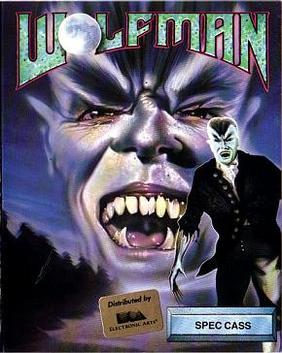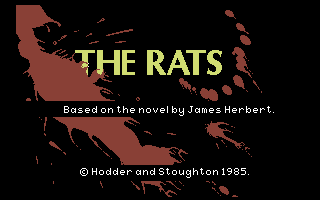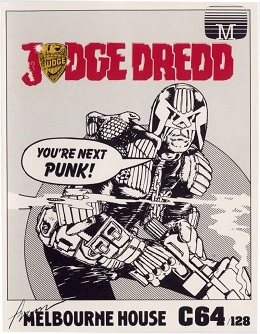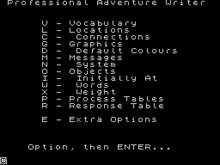Sinclair BASIC is a dialect of the programming language BASIC used in the 8-bit home computers from Sinclair Research, Timex Sinclair and Amstrad. The Sinclair BASIC interpreter was written by Nine Tiles Networks Ltd.

The Quill is a game creation system for text adventures. Written by Graeme Yeandle, it was published on the ZX Spectrum by Gilsoft in December 1983. Although available to the general public, it was used by several games companies to create best-selling titles; over 450 commercially published titles for the ZX Spectrum were written using The Quill.

The Horace video game series was created in the 1980s by William Tang for Beam Software. The series comprised Hungry Horace, Horace Goes Skiing and Horace and the Spiders.
Gilsoft was a British developer of video games and related utilities. The company was best known for developing the text adventure authoring tool The Quill and its successor, Professional Adventure Writer.

CRL Group plc was a British video game development and publishing company. Originally CRL stood for "Computer Rentals Limited". It was based in King's Yard, London and run by Clem Chambers.

The Hobbit is an illustrated text adventure computer game released in 1982 for the ZX Spectrum home computer and based on the 1937 book The Hobbit, by J. R. R. Tolkien. It was developed at Beam Software by Philip Mitchell and Veronika Megler and published by Melbourne House. It was later converted to most home computers available at the time including the Commodore 64, BBC Micro, and Oric computers. By arrangement with the book publishers, a copy of the book was included with each game sold.

Artic Computing was a software development company based in Brandesburton, England from 1980 to 1986. The company's first games were for the Sinclair ZX81 home computer, but they expanded and were also responsible for various ZX Spectrum, Commodore 64, BBC Micro, Acorn Electron and Amstrad CPC computer games. The company was set up by Richard Turner and Chris Thornton. Charles Cecil, who later founded Revolution Software, joined the company shortly after it was founded, writing Adventures B through D. Developer Jon Ritman produced a number of ZX81 and Spectrum games for Artic before moving to Ocean Software.

Knight Tyme is a computer game released for the ZX Spectrum, Amstrad CPC, Commodore 64 and MSX compatibles in 1986. It was published by Mastertronic as part of their Mastertronic Added Dimension label. Two versions of the ZX Spectrum release were published: a full version for the 128K Spectrum and a cut-down version for the 48K Spectrum that removed the music, some graphics and some locations.
Crystal Computing, later renamed Design Design, was a British video game developer founded in 1982 by Chris Clarke and Ian Stamp while students at the University of Manchester. Graham Stafford, Neil Mottershead, Simon Brattel and Martin Horsley, joined the company as it expanded. The company's first software release was a compilation of games for the Sinclair ZX81, though it was with the ZX Spectrum that Crystal found its greatest success. A deal with the machine's manufacturer Sinclair to distribute Crystal's Zeus Assembler gave the company sufficient funds for a major marketing campaign for their next product, Halls of the Things, an arcade adventure game that became their most successful title.

Terrormolinos is a text adventure released by Melbourne House in 1985 for the ZX Spectrum, Commodore 64, Amstrad CPC, BBC Micro and Acorn Electron, all retailing for £7.95.
The ZX Spectrum's software library was very diverse. While the majority of the software produced for the system was video games, others included programming language implementations, Sinclair BASIC extensions, databases, word processors, spread sheets, drawing and painting tools, and 3D modelling tools.

Graphic Adventure Creator is a game creation system/programming language for adventure games published by Incentive Software, originally written on the Amstrad CPC by Sean Ellis, and then ported to other platforms by, amongst others, Brendan Kelly (Spectrum), Dave Kirby and "The Kid" (C64). The pictures in the demo adventure, Ransom, were made by Pete James and the box cover art by Pete Carter.
Rigel's Revenge is a text adventure published in 1987 for the Amstrad CPC, Commodore 64, and ZX Spectrum home computers by Mastertronic on their "Bulldog" label. It was written by British studio Smart Egg Software using a heavily modified version of The Quill, an adventure-authoring package.

Dark Sceptre is a strategy adventure video game by Mike Singleton's design team Maelstrom Games, for Beyond Software. It was published by Firebird Software for the ZX Spectrum in 1987 and for the Amstrad CPC in 1988.

Jack the Ripper is a text adventure computer game designed by St. Bride's School and released by CRL in 1987 for the Commodore 64, Amstrad CPC and ZX Spectrum home computers. The game is based on the notorious "Jack the Ripper" murders in 1880s London.

Wolfman is a text adventure video game released by CRL in 1988 for the Commodore 64, Amstrad CPC, and ZX Spectrum home computers.

Silicon Dreams is a trilogy of interactive fiction games developed by Level 9 Computing during the 1980s. The first game was Snowball, released during 1983, followed a year later by Return to Eden, and then by The Worm in Paradise during 1985. The next year they were vended together as the first, second and last of the Silicon Dreams.

The Rats is a survival horror text adventure for the Commodore 64 and ZX Spectrum computers. It is based on the 1974 novel The Rats by James Herbert. The game was programmed by GXT, and published by Hodder & Stoughton, who were the publishers of James Herbert's book The Rats. An Amstrad CPC version was planned, but was never released.

Mined-Out is a maze video game created by Ian Andrew originally for the ZX Spectrum home computer in 1983. The objective is to carefully navigate a series of grid-shaped minefields by moving from the bottom to the top of the screen. The number of invisible mines in spaces adjacent to the player's current position is shown but not their precise location, requiring deduction to advance past them and avoid getting blown up. Additional challenges are introduced in later stages.

Judge Dredd is a platform shoot 'em up video game based on the character of the same name. It was developed by Beam Software and published by Melbourne House. It was released in Europe in 1986, for Commodore 64 and ZX Spectrum.














